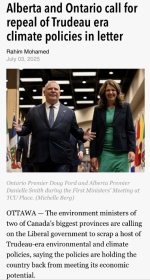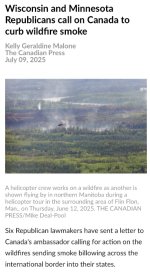Private jets polluted more than all flights from Heathrow, study finds
Author of the article:Washington Post
Washington Post
Anusha Mathur
Published Jun 27, 2025 • 4 minute read
Celebrities and business leaders like Taylor Swift and Starbucks CEO Brian Niccol may generate the occasional controversy with their frequent use of private jets, but capturing the full environmental impact of private aviation has remained a challenge.
Now, a new report from the nonprofit International Council on Clean Transportation sheds light on which nations are driving the largest share of this planet-warming pollution – and which airports stand out.
“It’s pretty well known that in a typical year, private jets are responsible for about 2 percent of aviation emissions,” said Dan Rutherford, the group’s senior director of research and a co-author of the new report. “What we’ve done for the first time is, we’ve basically used flight trajectory data to break that out into the individual contributions of airports and countries.”
The study spotlights the outsize impact of the United States on emissions. Globally, private jets emitted up to 19.5 million metric tons of greenhouse gases in 2023: Aircraft departing from the United States accounted for 65 percent of global private jet flights, and 55 percent of those gas emissions.
That year, private jets polluted more than the total of all commercial flights departing from London’s Heathrow Airport, Europe’s busiest hub.
Researchers identified 22,749 private jets by unique tail number that operated over 3.57 million flights.
The analysis is the first effort to combine flight trajectory information with publicly available emissions models to allocate private jet activity to specific airports.
The study also modeled air pollution, meaning it considered not only greenhouse gases but also nitrogen oxide pollution and fine particulate matter – both associated with significant human health risks. Researchers found that 18 of the 20 most polluting airports for private jet use are in the United States. And the majority of these flights are short-haul trips, lasting under two hours.
“If you look at individual airports that are polluted from private jets, Van Nuys Airport [in Los Angeles] popped out,” Rutherford said. “This is getting a lot of visibility because it’s where the celebrities and influencers are all parking their planes.”
Short-haul flights, defined as covering distances less than around 930 miles, account for roughly a third of aviation’s annual carbon output. Airplanes burn a significant amount of fuel when taking off and climbing to altitude, making these trips less efficient than longer ones.
France imposed a ban on short-haul domestic flights in 2023, but because it was limited to trips within its borders, analysts described the policy’s impact as modest.
Private jets generate between five and 14 times more greenhouse emissions per passenger than commercial planes, according to the European clean transportation nonprofit group Transport & Environment, and 50 times more emissions than trains travelling that same distance.
While private jets often show up in large numbers in big events, from the World Economic Forum at the Swiss resort of Davos to the Super Bowl, the United States still ranks higher than other wealthy countries. The new data shows 687 private jet flights per 10,000 people in the United States, compared to just 117 in the United Kingdom and 107 in France. Florida and Texas alone generated 543,815 flights – more than the entire European Union.
“With smaller, private aircrafts, you don’t have as many passengers to distribute the emissions across, so you lose some economies of scale,” said Colin Murphy, associate director of the Energy Futures Research Program at the UC-Davis Institute of Transportation Studies, who was not involved in the study.
“We have a lot of millionaires and billionaires,” Rutherford said. “We’re a highly unequal society, and so that generates a lot of traffic.”
This week dozens of private jets are expected to arrive in Venice for Jeff Bezos’s wedding. (Bezos is the owner of The Washington Post.)
Policy efforts to cut down on emissions from private aviation have largely fallen short. Legislation introduced in 2023 would have raised the federal fuel tax on private planes nearly ninefold, from $0.22 to $1.95 per gallon, but the bill never came to a vote.
At the same time, a Federal Aviation Administration program implemented last year allows some owners to remove their flight data from public distribution, making it more difficult to track private aircraft.
“The very important insight is that the global growth in emissions is coming from the top, from more people entering the very affluent classes that can afford private aviation,” said Stefan Gössling, professor of Tourism Research at Linnaeus University and Human Ecology at Lund University, who was not involved in the study. “That is a trend that is quite powerful and ongoing and will mean that we will not be able to meet our climate goals simply because there’s so much growth in the system that we cannot compensate.”
Still, researchers say that the data offers a stark picture of an elite mode of travel with an outsize climate footprint – one that has increased its emissions by 25 percent over the past decade.
“Private jets are like the canary in the coal mine here for a hyper unequal warming world,” Rutherford said.
"Private jets are like the canary in the coal mine here for a hyper unequal warming world," Rutherford said.

torontosun.com






